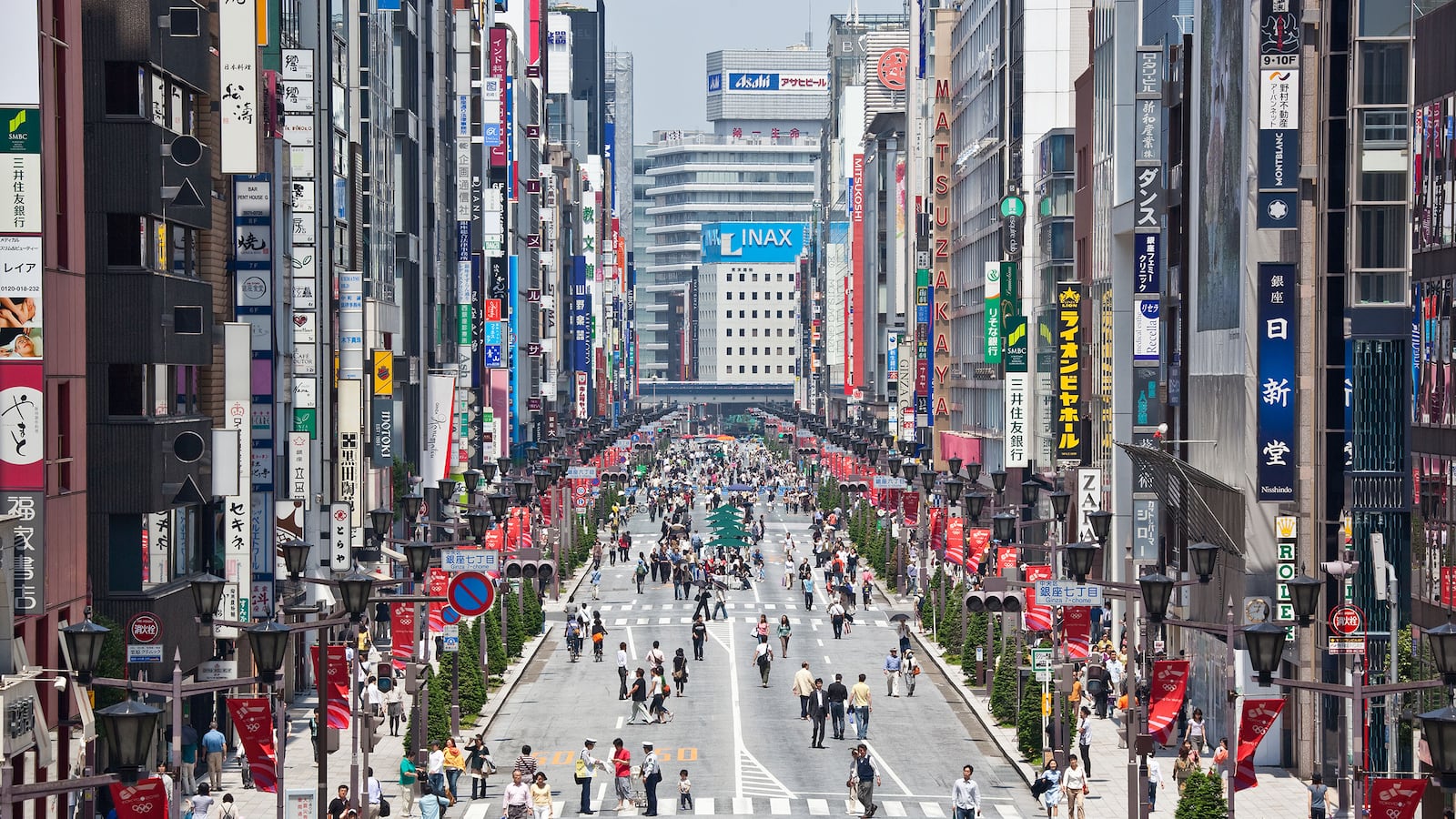Up at street level, its entrance is marked only by a small sign and a diminutive doorway, but the restaurant Tsurutokame teems way down, underground, below Tokyo’s most fashionable district.
Descending several flights of stairs, the place opens up at the bottom. A line of chefs behind the sushi bar greets me—all of them female, an extreme rarity in Japan. As one, they yell out Irasshaimase!, a warm welcome, and then return to their work, carving up giant crab, slicing Bluefin tuna and plating a wide variety of creations, from the bizarre—to the beautiful.
Tsurutokame is one of very few restaurants in Japan run exclusively by women, and these itamae chefs really go the extra mile, daily hand-writing haikus in flowing calligraphy that are then served up with the food, and working as a well-oiled machine—a result, at least in part, from the fact that they live together in dorms during their training, and hang out together, on their days off. And I marvel, as I tuck into course after course of sushi and sashimi and abalone and snow crab, that most people just walk by this place, up there on the busy sidewalks.

Tokyo’s trendiest neighborhood has always been about flash—from flagship fashion boutiques to mega-pricey gourmet restaurants. But I spent three days here in Ginza going deep, exploring the hidden side of this place, shopping and sipping and tasting the flavors at some of the 4,000 bars and restaurants contained within the borders of this two-square-kilometer district.
Located just southeast of Tokyo’s sprawling Imperial Palace, Ginza has long been the city’s leading neighborhood. Set on the long-ago site of a silver mine, the entire district burned to the ground in 1872. After that, the Meiji government designated the area to be a show-piece for the nation, prioritizing high-end modernization. New, European-style buildings emerged along broad boulevards, and Ginza became home to trend-setting magazines and newspapers. More recently, Ginza has developed into a destination for fashionistas, hosting national flagships of the world’s top designers, from Prada to Bulgari, Gucci, and Chanel, with one square meter of real estate here now selling for almost $90,000 USD.
My base for exploration is right in the heart of it all, the newly opened Hyatt Centric Ginza, sandwiched between a Louis Vuitton and the largest Armani outlet in the world. Inside, the hotel slowly reveals itself, reflecting back the surrounding streets in its design—blocks of hot type and a carefully curated collection of black-and-white photos on the walls, both derived (and curated) from the newspaper that once stood on this site, plus buttons and other fashion-forward elements sewn right into the décor. “Ginza isn’t just about high-end luxury—its diversity and flexibility make it special for locals, and visitors,” hotel GM Tadanori Uchiyama tells me. “The unique character of Ginza—it’s not seen anywhere else in Tokyo.”
Skipping the boutiques, for now, I walk one block to Ginza Six, a slick, super-luxe shopping center opened just last year. Passing up the flagships for top brands like Kenzo, Fendi and Yves Saint Laurent, I head all the way up to the thirteenth floor, to a quiet corner near the back, away from the main shopping concourses. A minimalist space, I settle into a stool at the bar at the Mixology Salon, a hole-in-the-wall that serves up green tea cocktails, or “teatails.”
The menu features Japanese twists on traditional mixes, with all the spirits—from soba cha vodka, to oolong-flavored rum—infused with green tea. I choose a Green Tea Fashioned, and the young woman behind the bar carefully prepares the drink in a beaker, pouring into a tumbler a mix of bourbon, chocolate and vanilla bitters, and matcha. Taking a big sip, the sweetness of the bourbon cuts the bitter edge on the matcha, a finely powdered green tea created in Tang dynasty China.

And I continue to imbibe on the neighboring blocks, proceeding into a what, at first glance, appears to be a nondescript office building, riding the elevator to the ninth-floor rooftop—which just happens to be covered in rice. The Tokyo office of Hakutsuru Sake, they grow some of their base product right there, in the heart of the city, a small crop that annually yields 15,000 liters of the good stuff. I spot a Shinto altar—which, I’m told, watches over the field, and the company—before joining the master brewer to try five different types of their rice wine.
Ginza is a place that will take you back in time, too, and I visit a series of shops so small, most of them allow barely enough room to turn around. At Nakamura Katsuji, a letterpress printing company—one of the very last in the neighborhood—I learn the ways of woodblock printing, as they’ve done it for more than 100 years, working the clanking, hand-operated machine myself. They print me up some business cards featuring my name in both English and Japanese, and the manager tells me that the majority of their business comes from the young, creative types who now work in the surrounding buildings.
Around the corner, I roll up my sleeves and fill up on some dorayaki, a sweet pancake filled with red-bean paste, at Kobikicho Yoshiya, where each of these treats has been made by hand for more than a century—their product has been selected as an official souvenir of the 2020 Olympics, which will be held in Tokyo. At the Okuno Building, once home to some of the priciest apartments in the city, I tour through living spaces that have now been converted into more than 20 galleries. And I join the masses of salarymen (and women) on their way home from work, teeming through the tiny alleyways, huddling at counters in izakaya.

And I finish my adventures—appropriately enough—back underground. Just a couple steps from the hotel, Bar Yu-Nagi is one of 50 tiny watering holes within 50 meters of its front door. I wind down into the subterranean labyrinth, finding a one-room, one-table bar with perhaps enough room for 20 people. Joined by a few friends, we pack the place, with bartender and owner Toshiyuki Kamiki, dressed in a traditional yukata (a summer kimono) mixing up drinks based on seasonal fruits and vegetables. We imbibe the fresh cocktails heartily, the room growing louder with each round, all of us feeling rather fortunate that we had found this tucked-away place, this underground spot that feels all our own, one more valuable find here in hidden Ginza.






